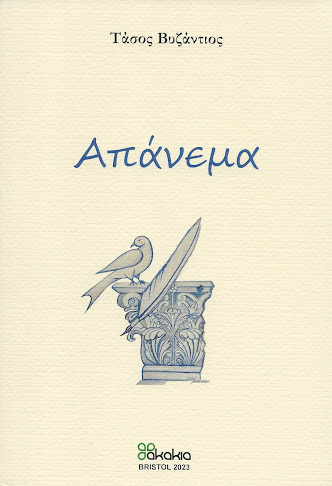Μια σημαντική καλλιτεχνική έκθεση ανοίγει τις πύλες της απόψε. Είναι η έκθεση πινάκων με γυαλί του Ελληνοκύπριου δημιουργού Γιώργου Παπαδόπουλου, η οποία θα είναι ανοικτή καθημερινά (10.00 π.μ. – 6.00 μ.μ.) από σήμερα μέχρι τις 27 Φεβρουαρίου στην «12 Star Gallery», 8 Storey’s Gate, London SW1P 3AT.
Τίτλος της έκθεσης είναι το «Δι’ εσόπτρου, εν αινίγματι» (“….Through a glass, darkly” στα Αγγλικά), το οποίο έχει ληφθεί από την Α’ προς Κορινθίους Επιστολή του Απ. Παύλου, κεφ. 13, στίχ. 12.
Όπως μας ενημερώνει η βασική οργανώτρια της έκθεσης αυτής Δρ. Νίκη Κατσαούνη, Κριτικός Τέχνης και Μορφωτική Σύμβουλος της Κυπριακής Ύπατης Αρμοστείας στο Λονδίνο: «Η έμπνευση για τα έργα αυτά ήλθε στον καλλιτέχνη από μια επίσκεψή του στο Άγιον Όρος, όπου μελέτησε τις εικόνες και σχημάτισε την άποψη ότι θα μπορούσαν να παραχθούν σήμερα και με άλλους τρόπους και υλικά, όπως π.χ. με γυαλί. Έχοντας υπ’ όψιν ότι η ουσία της βυζαντινής αγιογραφίας είναι η αποτύπωση του θείου, θεώρησε πως το γυαλί, με το χαρακτηριστικό της διαφάνειας που το διακρίνει, μπορεί να αποκαλύπτει αλλά και να αποκρύπτει μέσα του την εικονιζόμενη φιγούρα».
Αξίζει να παραθέσουμε και μερικές σκέψεις του ίδιου του δημιουργού: «Like most Greeks, I was raised in two visual traditions: a Western one, where novelty was at a premium; and an Orthodox tradition, which valued conformity above everything. To succeed as an artist in the non-Orthodox world, you had to come up with a new visual vocabulary. To be an Orthodox icon-maker, you had to learn a pictorial language handed down from artist to artist, unchanged, since the start of time. The question for me, as for many Greeks, is how to reconcile these two things: to make icons which are modern, but which respect the traditions of iconography. Icons aren't just images of holiness. They are holy, sometimes even acheiropoieton - made by saints, untouched by human hand. As one historian puts it, “the icon is a hole in the dyke separating the visible world from the divine, and through this hole ooze precious drops from the great sea of God's mercy.” The search for a new iconography is not something to be undertaken lightly. It struck me, on a retreat to Mount Athos a few years ago, that glass was the ideal medium for conducting this search. Icons have always been seen as windows between the human and divine worlds: glass is both transparent and capable of bearing an image, a revelation and a mystery. Abstraction -seeing reality in a non-realist way- is part of the iconic tradition. (Icon-makers have never gone in for perspective, or for naturalistic portraiture). After a lot of thought, I have set to work on a series of icons of mainly the Madonna and child which will, I hope, place Orthodox traditions in a modern context -see miracles in new technology, signs of God's genius in materials like fluorescent paint. The Virgin is both the Mother of God and a woman. She is eternal, but also mortal; unchanging, but capable of change».













































3 comments:
"Και ποιος δεν έγινε άνεμος
Στον άνεμο, ποιος δέντρο
Στο δάσος; ως δι’ εσόπτρου
βλέπουμε να διαβαίνει
ο τρέμων μίσχος"
Δ.Π.Παπαδίτσας, Εν Πάτμω, 1962.
@ Big Mama,
Στυλωμένη στους βράχους δίχως χτες και αύριο,
Στους κινδύνους των βράχων με τη χτενισιά της θύελλας
Θ' αποχαιρετήσεις το αίνιγμά σου.
Οδυσσέας Ελύτης
Θαυμάσιος Ελύτης π. Αναστάσιε...
Ό,τι πρέπει για τα...αινίγματα της Φιλοκαλίας που με "απασχολούν".
Να είστε καλά.
Post a Comment